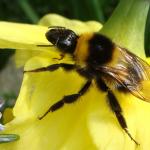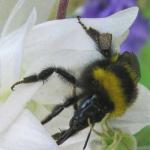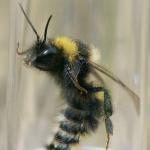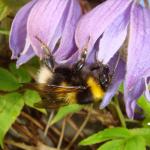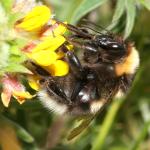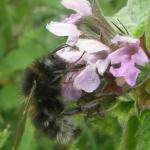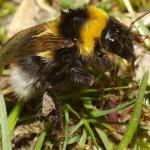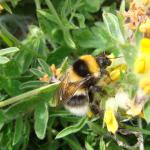Bombus meridionalis DALLA TORRE,1879:13; Bombus hispanicus PITTIONI, 1939c:244, nec FRIESE, 1911:571 (= B. monticola Smith); Megabombus asturiensis TKALCU, 1975:181 replacement name for hispanicus PITTIONI, 1939c: 244; Megabombus ?reinigiellus RASMONT, 1983:43; Megabombus dejonghei RASMONT 1982
After P. Williams: http://www.nhm.ac.uk/research-curation/research/projects/bombus/mg.html#hortorumA large bumblebee with a very long tongue, which is often held outstretched as the bee approaches a flower. It is one of three species found visiting very deep blooms such as foxglove (Digitalis purpurea) and honeysuckle (Lonicera periclymenum) (the other bees being B. pascuorum and B. ruderatus). Separating B. hortorum from its close relative B. ruderatus is very difficult and has resulted in considerable problems in establishing the range of the latter species. (See BWARS Newsletter, Autumn 2004, pp 27-28).
Found throughout the British Isles (including the Channel Islands and Ireland), although often one of the less frequent of the commoner bumblebee species. Overseas it occurs across Northern and Central Europe and Asia, from the Atlantic to Western Siberia.
This species is not regarded as being of conservation concern.
A widespread, although not always a frequently found species. It colonises a range of habitats, although absent from many upland areas, especially if these are of a moorland character.
The species is eusocial with queens emerging from hibernation from March to June; workers are present from late April onwards, and males and new females from July to October.The colony cycle of this species is slightly earlier than that of is congener Bombus ruderatus. The species is much later emerging in northern Scotland and the Scottish Islands than in the south of England and allowance for this geographical variation must be made.
Nests are always under cover, but may be only shallowly underground, down to 50cm. As with most other bumblebees an old small mammal nest is used by the queen as a starting point for her nest. Mature nests are medium-sized, with about 100 workers (Løken 1973; Hagen 1994).
A wide range of flowers are visited, both for pollen and nectar, however this bee has a very marked preference for the flowers of red clover (Trifolium pratense) if these are available.
The cuckoo bumblebee Bombus barbutellus parasitises nests of this species.
Proofed: February 2012


